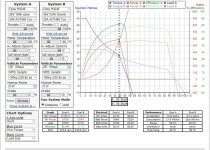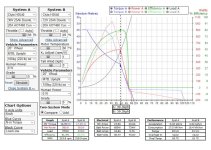grindz145
1 MW
A primer:
When using a hub-motor, at a given voltage, there is a maximum speed, which is based on the kV of the motor, which is related to the turns ratio. A way that several members on the forum have achieved a higher top speed is through Wye-Delta Switching.
What does that mean?
View attachment Basic Theory.JPG
So you can effectively change the winding characteristic of the motor to allow for a higher top-speed. However, if you simply hardwire the motor into Delta, you sacrifice low end toque (that you need) and ultimately efficiency. So a solution that a few members on the forum have experimented with is to switch from Wye-Delta on the fly.
View attachment Relay Switching.JPG
Yeah, I know, my drawings blow...
It recently came back to my attention when Hyena posted one of the hub motors that he modded in the for-sale section.
View attachment star-delta_relays.jpg
http://www.endless-sphere.com/forums/viewtopic.php?f=9&t=23079&p=362884#p362884
http://www.endless-sphere.com/forums/viewtopic.php?f=6&t=14954&start=150
Other members such as Doctorbass have tried this as well with pretty good results.
There are a few issues to be aware of:
1. You need a baller-ass controller. Once you lower the phase impedance, current control is much harder for the controller.
2. Relays that fit in hubmotors will probably not be rated for the current you need to push through them, which will ultimately lead to unreliability and failure. (though some have done pretty good with reliability)
3. Most relays that are being used are not rated for ebike voltages either. This can be mitigated for the most part, by making sure that the relay is only switched when the throttle is closed (IE no current is flowing to the motor).
4. The wiring is complex and you do need to feed a couple of extra signal wires through the axle to power the relays.
5. Doing 45+mph on most bicycle frames is for OGs only.
I proposed using a mosfets to perform the switching, Ill include that discussion in another post.
P.S.: just found the old thread with better drawings and more detail 8) : http://www.endless-sphere.com/forums/viewtopic.php?f=2&t=9215&hilit=doctorbass+wye+delta+switching
8) : http://www.endless-sphere.com/forums/viewtopic.php?f=2&t=9215&hilit=doctorbass+wye+delta+switching
When using a hub-motor, at a given voltage, there is a maximum speed, which is based on the kV of the motor, which is related to the turns ratio. A way that several members on the forum have achieved a higher top speed is through Wye-Delta Switching.
What does that mean?
View attachment Basic Theory.JPG
So you can effectively change the winding characteristic of the motor to allow for a higher top-speed. However, if you simply hardwire the motor into Delta, you sacrifice low end toque (that you need) and ultimately efficiency. So a solution that a few members on the forum have experimented with is to switch from Wye-Delta on the fly.
View attachment Relay Switching.JPG
Yeah, I know, my drawings blow...
It recently came back to my attention when Hyena posted one of the hub motors that he modded in the for-sale section.
View attachment star-delta_relays.jpg
http://www.endless-sphere.com/forums/viewtopic.php?f=9&t=23079&p=362884#p362884
http://www.endless-sphere.com/forums/viewtopic.php?f=6&t=14954&start=150
Other members such as Doctorbass have tried this as well with pretty good results.
There are a few issues to be aware of:
1. You need a baller-ass controller. Once you lower the phase impedance, current control is much harder for the controller.
2. Relays that fit in hubmotors will probably not be rated for the current you need to push through them, which will ultimately lead to unreliability and failure. (though some have done pretty good with reliability)
3. Most relays that are being used are not rated for ebike voltages either. This can be mitigated for the most part, by making sure that the relay is only switched when the throttle is closed (IE no current is flowing to the motor).
4. The wiring is complex and you do need to feed a couple of extra signal wires through the axle to power the relays.
5. Doing 45+mph on most bicycle frames is for OGs only.
I proposed using a mosfets to perform the switching, Ill include that discussion in another post.
P.S.: just found the old thread with better drawings and more detail



